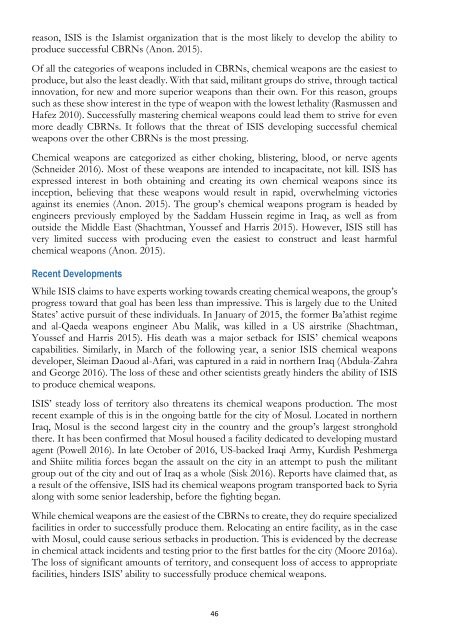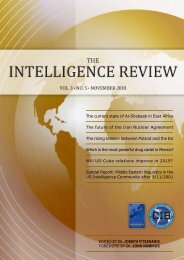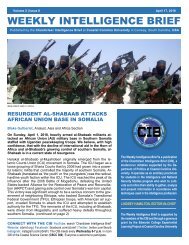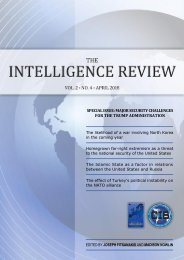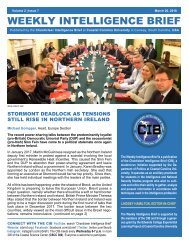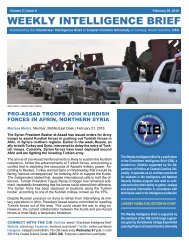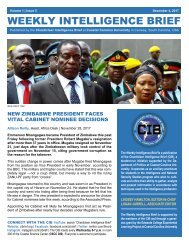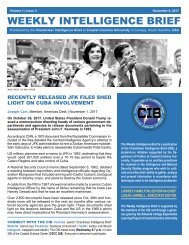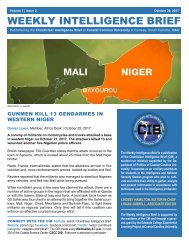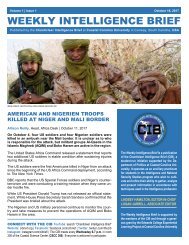The Intelligence Review | volume 1 | issue 2 |
This volume is the product of a collaboration between the European Intelligence Academy (EIA) and the Chanticleer Intelligence Brief (CIB), a student-run initiative supported by the Department of Politics at Coastal Carolina University in Conway, South Carolina, United States. Eleven CIB analysts tackle some of the most pressing and timely questions confronting intelligence observers today. Topics include the gun control debate in the United States, Russia’s involvement in the Syrian Civil War, the future of Kurdish nationalism, and the internal Palestinian dispute between Hamas and Fatah. Papers in this volume also examine the current state of Islamist extremism, and extrapolate on its future prospects in the Middle East, West Africa, the Lake Chad region, as well as in Southeast and Central Asia. CIB analysts propose carefully crafted and informed forecasts that outline future developments in some of the world's most unpredictable hot spots.
This volume is the product of a collaboration between the European Intelligence Academy (EIA) and the Chanticleer Intelligence Brief (CIB), a student-run initiative supported by the Department of Politics at Coastal Carolina University in Conway, South Carolina, United States. Eleven CIB analysts tackle some of the most pressing and timely questions confronting intelligence observers today. Topics include the gun control debate in the United States, Russia’s involvement in the Syrian Civil War, the future of Kurdish nationalism, and the internal Palestinian dispute between Hamas and Fatah. Papers in this volume also examine the current state of Islamist extremism, and extrapolate on its future prospects in the Middle East, West Africa, the Lake Chad region, as well as in Southeast and Central Asia. CIB analysts propose carefully crafted and informed forecasts that outline future developments in some of the world's most unpredictable hot spots.
- No tags were found...
You also want an ePaper? Increase the reach of your titles
YUMPU automatically turns print PDFs into web optimized ePapers that Google loves.
eason, ISIS is the Islamist organization that is the most likely to develop the ability to<br />
produce successful CBRNs (Anon. 2015).<br />
Of all the categories of weapons included in CBRNs, chemical weapons are the easiest to<br />
produce, but also the least deadly. With that said, militant groups do strive, through tactical<br />
innovation, for new and more superior weapons than their own. For this reason, groups<br />
such as these show interest in the type of weapon with the lowest lethality (Rasmussen and<br />
Hafez 2010). Successfully mastering chemical weapons could lead them to strive for even<br />
more deadly CBRNs. It follows that the threat of ISIS developing successful chemical<br />
weapons over the other CBRNs is the most pressing.<br />
Chemical weapons are categorized as either choking, blistering, blood, or nerve agents<br />
(Schneider 2016). Most of these weapons are intended to incapacitate, not kill. ISIS has<br />
expressed interest in both obtaining and creating its own chemical weapons since its<br />
inception, believing that these weapons would result in rapid, overwhelming victories<br />
against its enemies (Anon. 2015). <strong>The</strong> group’s chemical weapons program is headed by<br />
engineers previously employed by the Saddam Hussein regime in Iraq, as well as from<br />
outside the Middle East (Shachtman, Youssef and Harris 2015). However, ISIS still has<br />
very limited success with producing even the easiest to construct and least harmful<br />
chemical weapons (Anon. 2015).<br />
Recent Developments<br />
While ISIS claims to have experts working towards creating chemical weapons, the group’s<br />
progress toward that goal has been less than impressive. This is largely due to the United<br />
States’ active pursuit of these individuals. In January of 2015, the former Ba’athist regime<br />
and al-Qaeda weapons engineer Abu Malik, was killed in a US airstrike (Shachtman,<br />
Youssef and Harris 2015). His death was a major setback for ISIS’ chemical weapons<br />
capabilities. Similarly, in March of the following year, a senior ISIS chemical weapons<br />
developer, Sleiman Daoud al-Afari, was captured in a raid in northern Iraq (Abdula-Zahra<br />
and George 2016). <strong>The</strong> loss of these and other scientists greatly hinders the ability of ISIS<br />
to produce chemical weapons.<br />
ISIS’ steady loss of territory also threatens its chemical weapons production. <strong>The</strong> most<br />
recent example of this is in the ongoing battle for the city of Mosul. Located in northern<br />
Iraq, Mosul is the second largest city in the country and the group’s largest stronghold<br />
there. It has been confirmed that Mosul housed a facility dedicated to developing mustard<br />
agent (Powell 2016). In late October of 2016, US-backed Iraqi Army, Kurdish Peshmerga<br />
and Shiite militia forces began the assault on the city in an attempt to push the militant<br />
group out of the city and out of Iraq as a whole (Sisk 2016). Reports have claimed that, as<br />
a result of the offensive, ISIS had its chemical weapons program transported back to Syria<br />
along with some senior leadership, before the fighting began.<br />
While chemical weapons are the easiest of the CBRNs to create, they do require specialized<br />
facilities in order to successfully produce them. Relocating an entire facility, as in the case<br />
with Mosul, could cause serious setbacks in production. This is evidenced by the decrease<br />
in chemical attack incidents and testing prior to the first battles for the city (Moore 2016a).<br />
<strong>The</strong> loss of significant amounts of territory, and consequent loss of access to appropriate<br />
facilities, hinders ISIS’ ability to successfully produce chemical weapons.<br />
46


